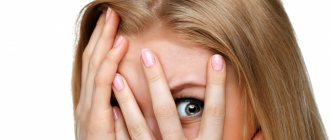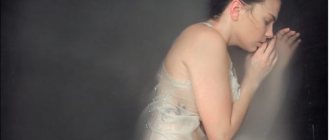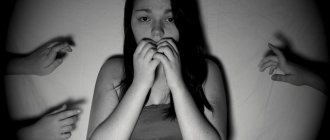Famous psychiatrists G.I. Kaplan and B.J. Benjamin distinguished between constructive and pathological fears. The last category includes the most common phobia of modern Americans - mysophobia. This concept was introduced into scientific use by W. Hammond at the end of the 19th century, when he studied obsessive-compulsive syndromes that manifest themselves in humans during frequent hand washing.
Mysophobia (translated from the Greek mysos - pollution, dirt, phobos - fear) is a person’s pathological fear of pollution or contamination, and as a result - an obsessive desire to avoid possible touching of surrounding objects and direct contact with other people. Sometimes this destructive fear is called germophobia (from the English germ - microbe) or fear of germs.
A person who suffers from this type of phobia exaggerates the possible danger to his health of microorganisms that surround him. Because of this false prejudice, mysophobes try to minimize the need to interact with strangers and avoid touching various things (all of which are potentially dangerous for them).
Recently, mysophobia has become increasingly common not only among residents of the United States, but also among the population of other countries. The main reason for the wide spread of this phobia is the media, which broadcast various commercials promoting cosmetic antibacterial products. The basis of such advertisements is the idea of instilling in people the information that the environment, teeming with pathogenic bacteria, is extremely dangerous for the human body, and therefore it is necessary to use various protective measures, including their “antiseptics.”
People suffering from mysophobia believe that if they wash their hands more often and treat objects around them with antibacterial products, they can reduce the likelihood of infection. But by such actions they only strengthen their phobia and, accordingly, themselves reduce the protective properties of the body.
Symptoms of mysophobia
Fear of germs and dirt has its own psychological, physiological and behavioral symptoms.
If a person has to touch a doorknob or physical contact with another person is possible, the mysophobe exhibits the following symptoms:
- pulse quickens;
- shortness of breath begins, shortness of breath begins;
- nausea and dizziness begin;
- the muscles of the body begin to spasm or tremors are observed.
Essentially, contact with anything causes panic, uncontrollable fear and disgust. Even if a person just goes along, it can cause a severe reaction, especially if he sneezed or coughed.
Psychologically, the disease of fear of dirt is manifested by the following symptoms:
- severe anxiety;
- attention wanders. A person can repeat the same action dozens of times, forgetting that he already did it a few minutes ago;
- being in a constant state of stress and depression.
Behavioral manifestation of fear of germs and dirt
- The patient washes his hands frequently and thoroughly and treats them with an antiseptic. In half an hour a person can wash their hands up to 25 times.
- Mysophobes often wear gloves and a mask on their hands to avoid touching or breathing in germs.
- Avoids crowded places and does not travel by public transport. It's torture for him to go into a store, let alone a public toilet.
- He does not offer his hand for a handshake, is reluctant to open the door, does not touch the railing and, in principle, avoids contact with anything that seems dirty to him.
- All personal items are separated from common items. He has his own office, his own dishes, food.
- They isolate themselves from society.
- A person makes his home perfectly clean and treats absolutely everything with an antiseptic. Often they do not allow anyone outside, not even relatives, into their home.
Naturally, this disease does not allow a person to live a full life, communicate with relatives and friends, or go to school or work. If a mysophobe tries to live an ordinary life, he often becomes an outcast in any group, since he seems strange and hostile to people.
What is mysophobe afraid of?
Literally translated, the term “mysophobia” means “fear of dirt”: the Greek words “mysos” (dirt) and “phobos” (fear) are used to form it. But also this pathology in medicine is called “germophobia” - from the English “germ” (microbe), that is, “fear of germs.”
In psychiatry, mental disorders with similar clinical manifestations are distinguished, for example, verminophobia - fear of insects, worms, viruses, microbes and bacteria (from the English “vermin” - “parasite”).
The main thing that a mysophobe (germophobe) is afraid of is getting sick, becoming infected, catching a virus, an infection. And dirt for him is a source of inexhaustible danger, because it is simply teeming with pathogenic microorganisms. The difference between a germaphobe and an ordinary neat person, even a perfectionist, is the scale of attention to the problem of cleanliness. Concentrating on this issue takes up so much energy and attention that it significantly interferes with living a peaceful life.
Additional Information! Famous mysophobes:
- The poet Vladimir Mayakovsky never touched a doorknob with his bare hand, but only with gloves, using a scarf, or even wrapping it in paper. He always carried a bar of soap with him so that he could immediately wash his hands after shaking hands.
- US President Donald Trump has admitted in public interviews that he hates shaking hands because “your hands are simply teeming with bacteria.”
- The famous inventor Nikola Tesla, according to the stories of his contemporaries, could not touch dusty objects, constantly washed his hands and was terrified of germs.
The phobia of dirt is so widespread in the world that many authors of works of fiction endow their heroes with this fear, as a distinctive character trait. Misophobes can be found in books, feature films and animation. And although authors usually make fun of the “eccentricity” of their characters, in real life a person suffering from mysophobia (germophobia) experiences not a joking discomfort.
Causes of mysophobia
Scientists scanned the brain of a person suffering from a phobia of dirt and germs and found that all information about pollution is formed in the frontal lobe of the brain. This information is transmitted to the department that is responsible for removing dirt. A healthy person receives this information, eliminates dirt and calms down. For a mysophobe, this process of information transfer goes in cycles, and he constantly receives signals that dirt needs to be eliminated. This is what prompts him to wash his hands every minute, giving rise to real neurosis.
Based on the fact that a phobia is a psychological disorder, we can say that most often impressionable and psychologically unbalanced people suffer from phobias. Any information received from the media about terrible diseases, infections and germs can lead an impressionable person to a state of panic and phobic diseases. But there are other reasons for the fear of dirt and germs:
Among the main factors that contribute to the formation of panic fear of dirt, it should be noted:
- A negative experience if a person has suffered some kind of illness or someone close to you has become ill as a result of infection in a public place. For example, AIDS. This is the disease that most frightens mysophobes.
- Often the cause is childhood psychological trauma. This is especially true for those children whose parents strictly potty trained their child and positioned failure as an “accident.” Such a child begins to be afraid of uncleanliness, becomes too pedantic and clean, fearing punishment.
- This disease can also be inherited if one of the relatives suffered from this phobia.
- Undoubtedly, the media has an influence, telling horrifying stories about diseases and indicating terrible numbers of increasing incidence. Then the person convinces himself that such a danger awaits him too.
- Anxious behavior, anxiety and depression are hereditary.
The fear of germs and dirt drives a person almost to madness. It becomes an obsession that is simply impossible to get rid of on your own. To treat dirt phobia, which is called mysophobia, you need the help of a specialist.
Prevention
As a preventive measure, it is recommended to increase stress resistance, treat diseases in a timely manner, and lead an active lifestyle. People at risk should be attentive to their health, and at the slightest sign of phobias or neuroses, consult a psychologist. It is recommended to get rid of such qualities as suggestibility, suspiciousness, and perfectionism.
It is important! Parents should be more loyal to their children and not punish them for every soiled sweater or unsuccessful trip to the toilet. Don't frighten your child with germs.
Treatment of mysophobia
Today, there are several fairly effective methods for treating mysophobia:
- Drug treatment. A person is prescribed sedatives and antidepressants to calm the nervous system and the brain stops transmitting endless signals to eliminate pollution. But this method is not very effective, since after the end of the course of taking the drugs, the symptoms return.
- Psychotherapy. It is usually combined with drug treatment.
In psychotherapy, cognitive behavioral therapy is used, which consists of 4 stages of treatment:
- To begin with, the patient is helped to realize that he washes his hands not because they are dirty, but because he is sick. That is, at this stage it is important to recognize that there is a problem that needs to be worked on;
- Next they look for the cause of the disease. The psychologist conducts individual consultations, where he tries to find out where the fear of dirt and germs began;
- then techniques are implemented that help a person escape from these obsessive thoughts and engage in other interesting activities;
- At the last stage, a reassessment of one’s behavior occurs. In essence, the patient is given the opportunity to look at himself from the outside.
- One method of combating phobia is hypnosis.
- One way to overcome your fear is to face it. Patients are asked to touch something dirty and interact with sick people. This part of the treatment is very difficult for patients, but it is one of the most effective ways to overcome their fear. For example, not washing your hands for 5 minutes, touching the trash, shaking hands with a sick person.
Development of a phobia
The fear experienced by a person, aimed at fear of contact with dirt and pathogenic microorganisms, manifested in excessive cleanliness, is called mysophobia.
The development of this condition includes several stages.
- The person’s first thoughts arise that at any moment it is possible to become infected with microbes or a serious disease.
- A person washes his hands more often and keeps his surroundings clean.
- Doubts arise whether the hands are really washed well and how clean the objects in the environment are.
- There is a need for better cleaning as well as disinfection of everything around the person with the phobia.
- Relief comes, which is temporary.
- A person begins to fear not only for himself. He worries that he could become a carrier of infection and harm his loved ones. Therefore, he is protected from any communication.
How to learn to live with mysophobia?
Undoubtedly, the disease of fear of dirt needs to be treated. But how can you learn to live with this illness while you are being treated?
A person with such a disorder is in constant stress; any daily activities seem like torture to him. Therefore, you need to overcome yourself, not isolate yourself, but talk about it with a person you trust. He will calm you down, support you and help you cope with the disease. In addition, after a course of psychotherapy, you still need to periodically visit a psychologist who will support you.
You need to find something interesting to do to distract yourself from obsessive thoughts. For example, read fascinating books, watch interesting films, watch travel programs. In general, do anything that can distract you, lift your spirits, and show you the joyful life you can afford if you get rid of your phobia.
Advice from psychologists
If in your case the phobia is tenacious, then until a positive result of psychotherapy is achieved, the recommendations of psychologists, developed specifically for people with obsessive-compulsive disorder, will help you:
- internally accept your fear: the more you try to “distract yourself, not think, not pay attention,” the more afraid you become;
- master physiological relaxation methods: there are special exercises, breathing exercises, meditative practices that allow a person to relax and calm down;
- lead a healthy lifestyle;
- find an effective psychological technique for dealing with fear: for example, writing out your worries on paper, deliberately creating positive images, etc.
Of course, observing the rules of personal hygiene, keeping the body, clothes, and home clean is necessary. Dirt can really make you sick. But it is important to see the line between healthy cleanliness and the already painful desire for sterile cleanliness. After all, life in constant fear is very difficult. Pathological fear no longer points to the peculiarities of a person’s worldview, but to a medical diagnosis, a disease that can and definitely must be treated.
What are the consequences of mysophobia if left untreated?
In society such a person becomes an outcast. Because of his fear and strange behavior, he loses his family, job, and friends. Many people close themselves off from the outside world and practically never leave the house. This leads to an even more severe psychological disorder, which can result in deep depression and even provoke the development of schizophrenia.
A person not only loses the opportunity to live a full life, but can also commit suicide. Since this is a condition, obsessive thoughts haunt him and do not give him peace for a second.
It is important to understand that there is always a way out. You should never give up and fight the disease to the end.
By the way, this phobia is quite common. Here is an example of famous people with a fear of dirt who have learned to live a full life despite their illness: Natalie Portman, Michael Jackson, Cameron Diaz, Megan Fox, Donald Trump, Denise Richards, Shannen Doherty and Nikola Tesla.
What is the danger of such a phobia?
Loneliness and depression are possible consequences of mysophobia.
In a situation where the fear of pollution and pathogenic microorganisms becomes pathological, consequences arise that manifest themselves in social and mental terms.
- Regular avoidance of communication with people has a negative impact on work, friendships, and family life.
- The actions of a mysophobe may be seen as hostile if people are unaware of their phobia.
- Such a person can become an outcast in society.
- Prolonged stay in this state can lead to depression and even schizophrenia.
Diagnostics
Psychotherapists diagnose mysophobia. Based on the patient's symptoms, they can tell what is bothering him. According to experts, this pathology does not pose any particular problems. It responds well to treatment if the person himself becomes interested in his recovery.
In the process of diagnosing fear, which is called mysophobia, it is important to distinguish this disorder from other, more serious pathologies. Fear of germs can be confused with the following disease conditions:
- Neurosis-like form of schizophrenia.
- Schizotypal disorder.
- Paranoid schizophrenia.
These pathologies are associated with delusional and obsessive states that have nothing to do with phobias.










